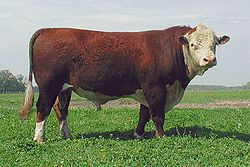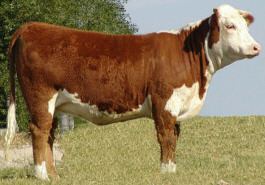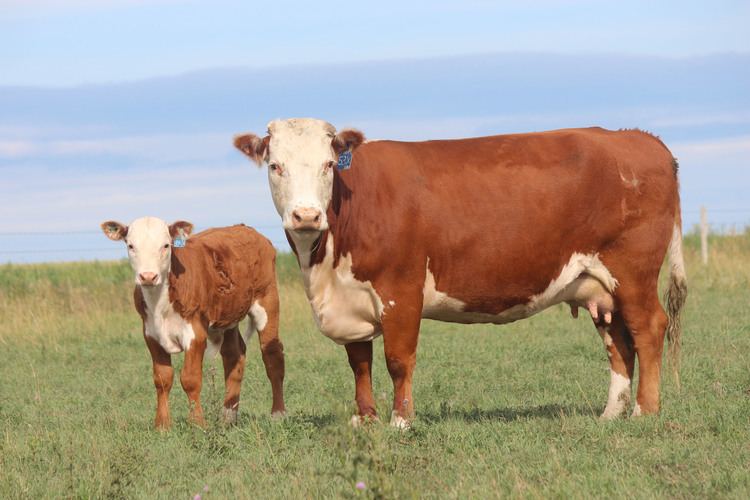Scientific name Bos taurus Higher classification Cattle | Rank Breed | |
 | ||
Similar Angus cattle, Charolais cattle, Simmental cattle, Shorthorn, Limousin cattle | ||
Hereford cattle are a beef cattle breed, widely used in many different climates, primarily for meat production.
Contents
Originally from Herefordshire, England, United Kingdom, more than five million pedigree Hereford cattle now exist in over 50 countries. The Hereford cattle export trade began from United Kingdom in 1817, starting in Kentucky, United States, spreading across the United States and Canada through Mexico to the great beef-raising countries of South America. Today, Hereford cattle dominate the world scene from Australasia to the Russian steppes. They can be found in Israel, Japan and throughout continental Europe and Scandinavia.

They are found in the temperate parts of Canada, the United States, Kazakhstan and Russia, as well as the temperate parts of Australia, the centre and east of Argentina, in Uruguay, in Chile and New Zealand, where they make up the largest proportion of registered cattle. They are found all around Brazil and they are also found in some Southern African countries (mainly in South Africa, Zambia and Zimbabwe). They originally found great popularity among ranchers of the American Southwest, testament to the hardiness of the breed; while originating in cool, moist Britain, they have proven to thrive in much harsher climates on nearly every continent.

The World Hereford Council is based in the United Kingdom; the Secretary General, Mrs. Jan Wills, is from New Zealand. There are currently 17 member countries with 20 Hereford societies and 10 nonmember countries, with a total of eight societies.

History

Until the 18th century, the cattle of the Herefordshire area were similar to other cattle of southern England, being wholly red with a white switch, similar to the modern North Devon and Sussex breeds. During the 18th and early 19th centuries, other cattle (mainly Shorthorns) were used to create a new type of draught and beef cattle which at first varied in color, different herds ranging from yellow to grey and light brown, and with varying amounts of white. However, by the end of the 18th century the white face characteristic of the modern breed was well established, and the modern color was established during the 19th century.

The Hereford is still seen in the Herefordshire countryside today and featured prominently at agricultural shows. The first imports of Herefords to the United States were around 1817 by the politician Henry Clay, with larger importation of the breed beginning in the 1840s.
Polled Hereford

The Polled Hereford is a hornless variant of the Hereford with the polled gene, a natural genetic mutation that was selected into a separate breed beginning in 1889.
Iowa cattle rancher Warren Gammon capitalized on the idea of breeding Polled Herefords and started the Polled Hereford registry with 11 naturally polled cattle. American Polled Hereford Association (APHA) was formed in 1910. The American Polled Hereford and American Hereford breeds have been combined since 1995, under the same American Hereford Association name.
Traditional Hereford
Many strains of Hereford have used other cattle breeds to import desired characteristics, and this has led to changes in the breed as a whole. However, some strains have been kept separate, and these have retained characteristics of the earlier breed, such as hardiness and thriftiness. The Traditional Hereford is now treated as a minority breed of value for genetic conservation.
Health
Eye cancer (ocular squamous cell carcinoma) occurs in Herefords in particular in countries with continued bright sunlight and those that prefer traits of low levels of red pigmentation around the eye. Studies have been made into eye cancer in Hereford cattle in the US and Canada, and lid and corneoscleral pigment were found to be heritable and likely to decrease the risk of cancer. Vaginal prolapse is considered a heritable problem in Hereford cattle, but it may also be influenced by nutrition. Another problem is exposed skin on the udder being of light pigmentation and therefore vulnerable to sun burn.
Dwarfism is known to be prevalent in Hereford cattle and has been determined to be caused by an autosomal recessive gene. Due to equal occurrence in heifers and bulls, dwarfism is not considered a sex-linked characteristic.
